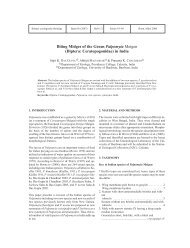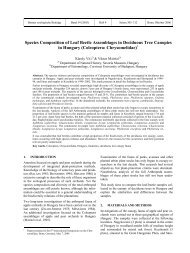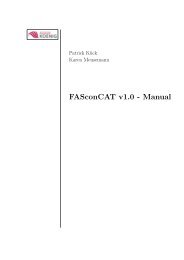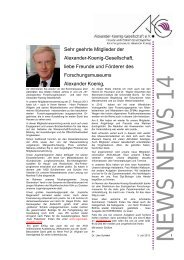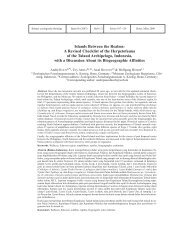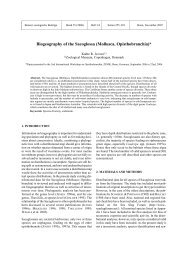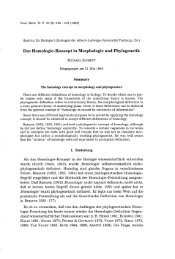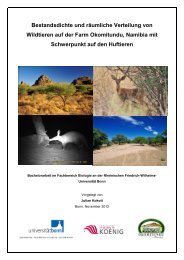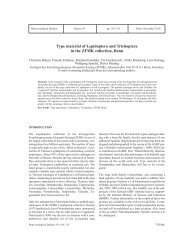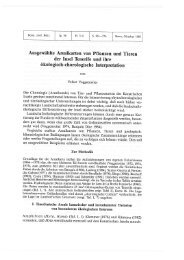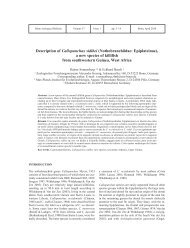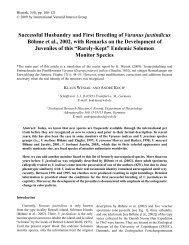cephalic shield
cephalic shield
cephalic shield
Create successful ePaper yourself
Turn your PDF publications into a flip-book with our unique Google optimized e-Paper software.
312 Sid STAUBACH & Annette KLUSSMANN-KOLB: Cephalic sensory organ in Aceton<br />
the cerebral nerves using axonal tracing. In an earlier study<br />
(STAUBACH et al. in press) these cellular innervation patterns<br />
were shown to be more adequate in homologising<br />
cerebral nerves than ganglionic origins of nerves (HUBER<br />
1993). By comparising the innervation patterns in A. tor -<br />
n a t i l i s to previously published data on H. hydatis<br />
(STA U B A C H et al. in pre s s), we want to survey whether the<br />
preliminary characteristic cell clusters in the central nervous<br />
system (CNS) of both taxa can be identified by homologising<br />
cerebral nerves across taxa. Based on the homologisation<br />
of the nerves innervating the CSOs we want<br />
to clarify if A. tornatilis has homologous structures to the<br />
CSOs of Cephalaspideans. It is our intent interest that we<br />
shed light on the phylogenetic position and evolutionary<br />
history of Acteonoidea within the Opisthobranchia for future<br />
studies.<br />
2. MATERIALS AND METHODS<br />
2.1. Specimens<br />
A. tornatilis (Fig. 1A) were collected in the wild at St.<br />
Michel en Greve (Brittany, France). They were then stored<br />
alive at our lab in Frankfurt. Fourty specimens measuring<br />
a shell length between 15 and 20 mm were traced directly<br />
(5 to 15 days after collecting) and five were fixed<br />
for SEM.<br />
2.2. Tracing studies<br />
Animals were relaxed with an injection of 7 % magnesium<br />
chloride. The central nervous system consisting of<br />
the cerebral, pleural and pedal ganglia was removed and<br />
placed in a small Petri dish containing filtered artificial<br />
seawater (ASW; Tropic Marin, Rebie-Bielefeld; GER-<br />
MANY). We then followed the procedures from CROLL<br />
& BAKER (1990) for Ni 2+ -lysine (Ni-Lys) tracing of axons.<br />
Briefly, the nerves of the right cerebral ganglion were<br />
dissected free from the connective tissue. The nerves were<br />
cut and the distal tip was gently drawn into a glass micropipette<br />
using suction provided by an attached 2.5 ml<br />
syringe. Subsequently, the saline in the micropipette was<br />
replaced by a Ni-Lys solution (1.9g NiCl-6H 2 O, 3,5 g L-<br />
Lysine freebase in 20 ml double distilled H 2 O). The preparation<br />
was then incubated for 12–24 hours at 8º C to allow<br />
transport of the tracer. The micropipette was then removed<br />
and the ganglia were washed in ASW three times.<br />
The Ni-Lys was precipitated by the addition of five to ten<br />
drops of a saturated rubeanic acid solution in absolute Dimethylsulfoxide<br />
(DMSO). After 45 minutes the ganglia<br />
were transferred to 4 % paraformaldehyde (PFA) and fixed<br />
for 4–12 hours at 4º C. Thereafter the ganglia were dehydrated<br />
in an increasing ethanol series (70/80/90/99/99%<br />
10 minutes each), cleared in methylsalicylate and mounted<br />
on an objective slide dorsal side up in Entellan (VWR<br />
International) and covered with a cover slip. Ten replicates<br />
were prepared for each cerebral nerve of A. tornatilis.<br />
Samples with only a partial staining of the nerve were not<br />
used because of possible incomplete innervation patterns.<br />
Our criterion for a well-stained preparation was a dark blue<br />
stained nerve indicating intact axons ( FR E D M A N 1 9 8 7 ). T h e<br />
Ni-Lys tracings were analysed by light microscopy (Leica<br />
TCS 4D). Camera lucida drawings were digitalised following<br />
the method of CO L E M A N ( 2 0 0 3 ) adapted for Corel-<br />
DRAW 11. The somata in the innervation scemes occurs<br />
in all replicates. Somata only occurring in single samples<br />
are not considered part of the schematics. The axonal pathways<br />
are estimated over all replicates. Additionally, we<br />
tested for asymmetries making axonal tracings (n = 2 to<br />
3) for each cerebral nerve of the left cerebral ganglion.<br />
2.3. Scanning electron microscopy studies<br />
The specimens were relaxed by an injection of 7 % Mg-<br />
C l 2 in the foot. T h e r e a f t e r, the entire head region was dissected<br />
from the rest of the animal. The CSOs were fixed<br />
in 2,5 % glutaraldehyde, 1 % paraformaldehyde in 0,1M<br />
phosphate buffer (pH 7,2) at room temperature. For the<br />
SEM, the fixed CSOs were dehydrated through a graded<br />
acetone series followed by critical point drying (CPD 030,<br />
BAL-TEC). Finally, they were spattered with gold (Sputter-Coater,<br />
Agar Scientific) and examined with a Hitachi<br />
S4500 SEM. All photographs were taken using DISS (Digital<br />
Image Scanning System – Point Electronic) and subsequently<br />
adjusted for brightness and contrast with Corel<br />
PHOTO-PAINT 11.<br />
3. RESULTS<br />
3.1. Organisation and innervation of the <strong>cephalic</strong> sensory<br />
organs<br />
A. tornatilis possesses a prominent bipartite <strong>cephalic</strong> <strong>shield</strong><br />
(cs) in which each hemisphere of this <strong>shield</strong> is divided into<br />
an anterior and a posterior lobe (Figs. 1A and B). Eyes<br />
are embedded deeply within the tissue of the <strong>shield</strong>. A l o n g<br />
the lateral margin of the anterior lobe of the <strong>cephalic</strong> <strong>shield</strong><br />
a groove is present (Fig. 1B, 2A). Hidden under the cs and<br />
above the foot, the mouth opening is situated at the median<br />
frontal edge (Fig. 2B) surrounded by the lip (not visible<br />
in Figure 2B). We found four nerves innervating the<br />
CSOs (Fig.1B). The N1 (Nervus oralis) provides innervation<br />
to the lip and small median parts of the anterior<br />
<strong>cephalic</strong> <strong>shield</strong>. The bifurcated N2 (Nervus labialis/labiotentacularis)<br />
innervates the complete anterior <strong>cephalic</strong><br />
<strong>shield</strong> whereby the groove at the ventral anterior lobe of<br />
the <strong>cephalic</strong> <strong>shield</strong> is especially innervated. The small N3<br />
(Nervus tentacularis/rhinophoralis) innervates a little re-




